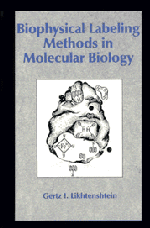Book contents
- Frontmatter
- Contents
- Preface
- Abbreviations
- 1 The method of spin labeling
- 2 Double-labeling techniques
- 3 Fluorescent labeling methods
- 4 Triplet labeling methods
- 5 Mössbauer spectroscopy, electron scattering, and other labeling methods
- 6 Studies of proteins and enzymes: structure, dynamics, and mechanism of action
- 7 Structure and dynamics of membranes
- 8 Nucleic acids and other biological systems: biological assays
- Conclusion
- References
- Index
7 - Structure and dynamics of membranes
Published online by Cambridge University Press: 29 January 2010
- Frontmatter
- Contents
- Preface
- Abbreviations
- 1 The method of spin labeling
- 2 Double-labeling techniques
- 3 Fluorescent labeling methods
- 4 Triplet labeling methods
- 5 Mössbauer spectroscopy, electron scattering, and other labeling methods
- 6 Studies of proteins and enzymes: structure, dynamics, and mechanism of action
- 7 Structure and dynamics of membranes
- 8 Nucleic acids and other biological systems: biological assays
- Conclusion
- References
- Index
Summary
The role of membrane participation in the fundamental biochemical and biophysical processes that produce the vital activities of all organisms cannot be overestimated. Biological membranes act as barriers to separate cell and subcellular structures; they also form ensembles of enzymes that catalyze chemically connected reactions, and they contain specific transportation channels for certain physiologically active compounds. Membranes perform transmembrane transport, regulate enzyme activity, and transmit electric and other biological signals. Practically all biologically essential phenomena, such as intercell interaction, cell division, mobility, differentiation, pathological processes, etc., are in some way associated with the peculiarities of structure and dynamics of biological membranes.
According to contemporary concepts, biomembranes are formed from lipid molecules arranged, as a rule, in bilayers. Biomembranes, with their great variety of ingredients, including protein and glycoprotein macromolecules and small compounds (electron and proton carriers, antioxidants, regulators of rigidity, etc.), “resemble a crowded swimming pool” (Jost & Griffith 1980).
The relative rigidity of the superficial portions of membranes, consisting of polar phosphatidyl and glyceryl fragments, and the flexibility of the hydrocarbon “tails” provide a unique combination of lateral and longitudinal stability for the frame and mobility for the inner membrane.
Specific modifications of individual parts of biological and model membranes by a whole set of labels and probes (Figure 7.1) allows the biological labeling method to be extremely effective; it is not infrequently the only tool for in-depth research in molecular membranology.
- Type
- Chapter
- Information
- Biophysical Labeling Methods in Molecular Biology , pp. 201 - 232Publisher: Cambridge University PressPrint publication year: 1993



